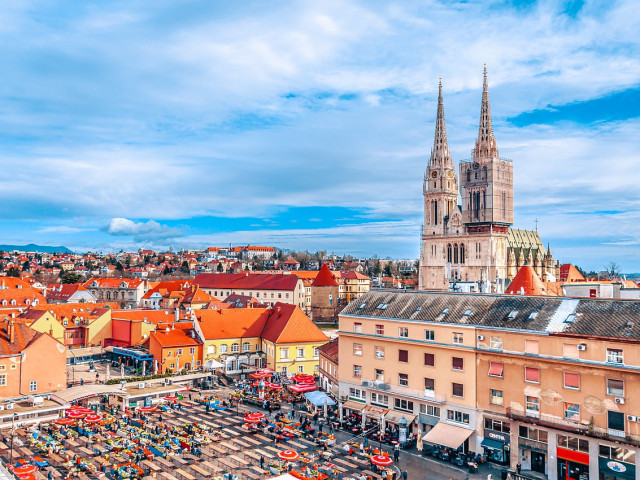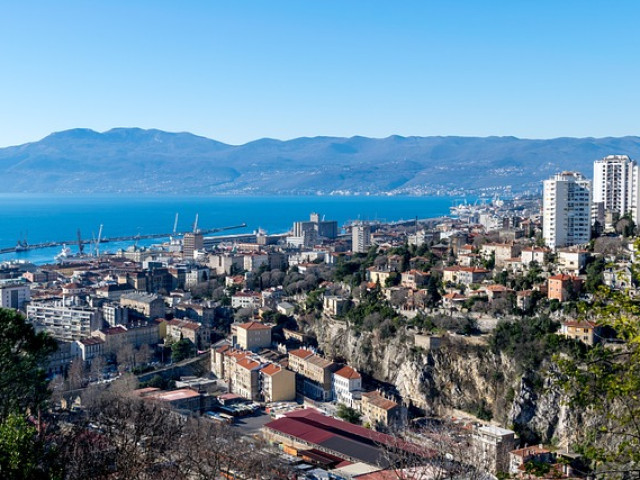
| Capital | Zagreb |
| Currency | Kuna |
| Languages | Croatian |
| Government | Republic |
| Timezone | GMT + 1 |
| Population | 4.5 million |
| Dialing code | (00) 385 |
Croatia’s coastline extends over thousands of kilometres, runs alongside over 1,000 offshore islands, is home to pretty Venetian old towns and rugged mountain ranges and provides traditional Adriatic seafood in abundance - pure paradise! Although its beautiful coast is undoubtedly the most important factor fuelling Croatia’s tourism industry, if you move off the beaten track you’ll also find Istria’s stunning hills, with hilltop towns, great food and excellent wines. In the country’s north, there are the historic castles of the Zagorje and in the Slavonia region, you can discover the riverside city of Osijek.
Where to buy tickets for Croatia
The Trainline
Booking Platform
The Trainline is a British digital rail and coach technology platform operating across Europe.
Visit The TrainlineSponsored Link
Omio
Booking Platform
Omio is a German online travel comparison and booking website based in Berlin.
Visit OmioSponsored Link
What to expect from the weather in Croatia
The most popular parts of Croatia are the Dalmatian coast and its islands in the Adriatic Sea. There, a mediterranean type of climate is dominant, meaning that you can expect mild winters and warm, sunny and sometimes very hot summers. On the coast, there is a cooling breeze in the summer; temperatures generally are between ten degrees Celsius in winter and twenty-six degrees Celsius summer. In the centre of the country, winter temperatures can be around the freezing-point, in summer, you get an average of 24 degrees Celsius. In the mountains the temperatures in winter are normally below freezing and it can snow considerably. Generally, you get a lot of sunshine in Croatia; up to 2500 hours per year.
Accommodation
There are good 4-star hotels along the coast and in Croatia’s inland. 5-star hotels are still mainly found in Zagreb or in popular coastal resorts like Dubrovnik.
The Ministry of Tourism officially rates the country’s hotels; there are five categories according to the international standards of accommodation, from luxury 5-star hotels to 1-star basic accommodation.
There are around 150 campsites in Croatia, some of them situated in naturist camps! The Croatian Camping Union will provide you with details.
Private accommodation is also available in Croatia and in most cases it’s best to arrange bookings through local tourist agencies who can guide you as to which ones to choose. During the main season, many places might request a minimum of three nights stay.
The Ministry of Tourism officially rates the country’s hotels; there are five categories according to the international standards of accommodation, from luxury 5-star hotels to 1-star basic accommodation.
There are around 150 campsites in Croatia, some of them situated in naturist camps! The Croatian Camping Union will provide you with details.
Private accommodation is also available in Croatia and in most cases it’s best to arrange bookings through local tourist agencies who can guide you as to which ones to choose. During the main season, many places might request a minimum of three nights stay.
What are the business hours?
Banks are normally open Monday - Friday 07.00-19.00, and Saturdays 07.00-13.00. Shops are open Monday - Friday 08.00-20.00, Saturdays 08.00-15.00 and in summer, many shops are also open on Sundays.
What about travel visas?
Nationals of the following countries can visit Croatia without a visa as long as they’re not staying for longer than 90 days:
Andorra, Argentina, Australia, Austria, Belgium, Bolivia, Bosnia & Herzegovina, Brazil, Brunei, Bulgaria, Canada, Chile, Costa Rica, Czech Republic, Cyprus, Denmark, Ecuador, El Salvador, Estonia, Finland, France, Germany, Great Britain, Greece, Guatemala, Hungary, Honduras, Iceland, Ireland, Israel, Italy, Jamaica, Japan, Latvia, Liechtenstein, Lithuania, Luxembourg, Macedonia, Malaysia, Malta, Mexico, Monaco, Netherlands, New Zealand, Nicaraqua, Norway, Panama, Paraquay, Poland, Portugal, Romania, the Republic of Korea, San Marino, Singapore, Slovakia, Slovenia, Spain, Sweden, Switzerland, Turkey, United States of America, Uruguay, Vatican City and Venezuela.
Andorra, Argentina, Australia, Austria, Belgium, Bolivia, Bosnia & Herzegovina, Brazil, Brunei, Bulgaria, Canada, Chile, Costa Rica, Czech Republic, Cyprus, Denmark, Ecuador, El Salvador, Estonia, Finland, France, Germany, Great Britain, Greece, Guatemala, Hungary, Honduras, Iceland, Ireland, Israel, Italy, Jamaica, Japan, Latvia, Liechtenstein, Lithuania, Luxembourg, Macedonia, Malaysia, Malta, Mexico, Monaco, Netherlands, New Zealand, Nicaraqua, Norway, Panama, Paraquay, Poland, Portugal, Romania, the Republic of Korea, San Marino, Singapore, Slovakia, Slovenia, Spain, Sweden, Switzerland, Turkey, United States of America, Uruguay, Vatican City and Venezuela.
How much should you tip in Croatia?
In most cases the service charge is included in the bill, so tipping is not necessary. However if you are in a large group or have received a service that you found to be excellent then a tip of 10-15% would be appropriate.
| ATM availability | Available |
| Emergency services | Ambulance, police and fire 112 |
| Tourist board | http://www.croatia.hr |
| Famous for | Neckties, wine, lavender, beaches |
| Useful phrases | Bog (hello); dovidenja (goodbye); hvala (thank you); pardon (sorry) |
History
After WWI, Croatia became part of the Kingdom of Serbs, Croats and Slovenes. During WW2 it was invaded by Germany in 1941, which allowed the radical right to come to power and introduce similar repressive policies as were in place in other European facist regimes: Serbs, Jews and Romany people were persecuted and hundreds of thousands were killed.
In 1945 Croatia became a part of the Socialist Federal Republic of Yugoslavia under the Communist leader Tito. Following his death in 1980 dissatisfaction with the status quo began to gather momentum which only intensified with the general climate of change across other Communist states of eastern Europe.
In 1991, Croatia declared independence from Yugoslavia under Franjo Tudman. In 1993, the Croatian army launched an offensive in southern Krajina, a part of the country that had earlier proclaimed independence from Croatia. The Dayton Agreement brought peace in 1995 and Franjo Tudman became the country’s first president although the regime became became increasingly unpopular amid allegations of corruption. In the 2000 election, Stipe Mesic became the new president, followed by Ivo Sanader in 2003.
Croatia is expected to become an EU member by the end of the decade.
In 1945 Croatia became a part of the Socialist Federal Republic of Yugoslavia under the Communist leader Tito. Following his death in 1980 dissatisfaction with the status quo began to gather momentum which only intensified with the general climate of change across other Communist states of eastern Europe.
In 1991, Croatia declared independence from Yugoslavia under Franjo Tudman. In 1993, the Croatian army launched an offensive in southern Krajina, a part of the country that had earlier proclaimed independence from Croatia. The Dayton Agreement brought peace in 1995 and Franjo Tudman became the country’s first president although the regime became became increasingly unpopular amid allegations of corruption. In the 2000 election, Stipe Mesic became the new president, followed by Ivo Sanader in 2003.
Croatia is expected to become an EU member by the end of the decade.
Politics
Croatia has a multi-party system, where parties have to work together in coalition governments as it is near-impossible to gain an outright majority in parliament under the system of proportional representation which has been adopted there.
Since the 2003 elections, the main topic of Croatia’s foreign policy has always been the admittance to the European Union.
Recently the political landscape in Croatia has been affected by signficant
alienation of Croats from mainstream politics. It was particularly evident in the latest local and presidential elections when there was a record low turnout in almost all regions. Even the voters who did turn out showed a rebellion against the mainstream and supported parties on the fringes of the system to a far greater extent than ever before rather than the traditional parties.
Since the 2003 elections, the main topic of Croatia’s foreign policy has always been the admittance to the European Union.
Recently the political landscape in Croatia has been affected by signficant
alienation of Croats from mainstream politics. It was particularly evident in the latest local and presidential elections when there was a record low turnout in almost all regions. Even the voters who did turn out showed a rebellion against the mainstream and supported parties on the fringes of the system to a far greater extent than ever before rather than the traditional parties.
Geography
Located in Southeastern Europe between Bosnia, Herzegovina and Slovenia, Croatia borders the Adriatic Sea and enjoys stunning coastlines there. The landscape varies greatly depending on where you are in the country. There are the flat plains along the Hungarian border; near the Adriatic coastline there are low mountains and highlands and along the coastline itself there are wonderful unspoilt, sandy beaches.
It's location means that it has control over most of the strategically important overland routes between northern and western Europe and the Aegean sea and Turkish straits, something which has proved a valuable economic resource in the past. The country further benefits from its rich landscape and wealth of natural resources including but not limited to its Petroleum, coal reserves, bauxite, natural asphalt, silica, salt and hydropower.
It's location means that it has control over most of the strategically important overland routes between northern and western Europe and the Aegean sea and Turkish straits, something which has proved a valuable economic resource in the past. The country further benefits from its rich landscape and wealth of natural resources including but not limited to its Petroleum, coal reserves, bauxite, natural asphalt, silica, salt and hydropower.
Economy
The economy of Croatia has moved away from agriculture which was previously dominant to one that is now largely service-based. The strength of the country's economy is ahead of states such as Romania, Lithuania and Poland.
The industrial sector is dominated by shipbuilding, with Croatia’s annual exports in this sector being worth over €1 billion. Food processing and the chemical industry are other significant factors in Croatia’s export industry.
The export of blue water fish, for which demand has increased tremendously over the last few years, mainly from Japan and South Korea, remains the only significant agricultural export. Smaller agricultural markets are in place for its organic food production, wines, olive oils and lavender.
Croatia is among the world’s top 20 most popular tourist destinations, so making this a major source of income, especially during the summer. Recently the tourist season has been extended through the winter as winter sports including skiing have successfully been promoted to visitors.
The industrial sector is dominated by shipbuilding, with Croatia’s annual exports in this sector being worth over €1 billion. Food processing and the chemical industry are other significant factors in Croatia’s export industry.
The export of blue water fish, for which demand has increased tremendously over the last few years, mainly from Japan and South Korea, remains the only significant agricultural export. Smaller agricultural markets are in place for its organic food production, wines, olive oils and lavender.
Croatia is among the world’s top 20 most popular tourist destinations, so making this a major source of income, especially during the summer. Recently the tourist season has been extended through the winter as winter sports including skiing have successfully been promoted to visitors.





